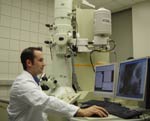



Context - Nanotechnologies refer to technologies which exploit the unique properties of tiny particles of nanometre size (millionths of a millimetre).
Nanotechnologies represent a fast-growing market; they are already being used in a variety of technologies and consumer products. (Click here![]()
However, materials containing nanoparticles may be of concern for human health and the environment, and the risks of these recently developed materials need to be assessed.
Are the existing methodologies to assess these risks appropriate?
An assessment by the European Commission Scientific Committee on Emerging and Newly Identified Health Risks (SCENIHR)
The answers to these questions are a faithful summary of the scientific opinion produced in 2006 by the Scientific Committee on Emerging and Newly Identified
Health Risks (SCENIHR): "![]()

1.1 Nanotechnology is the science of designing, producing, and using structures and devices having one or more dimensions of about 100 millionth of a millimetre (100 nanometres) or less.
Nanotechnology has the potential to significantly impact society. It is already used for instance by the information and communications sectors. It is also used in cosmetics and sunscreens, in textiles, in coatings, in some food and energy technologies, as well as in some medical products and medicines. Moreover, nanotechnology could also be used in reducing environmental pollution.
However, engineered nanoparticles can have very different properties and effects compared to the same materials at larger sizes, which may entail new health risks for humans and other species. Indeed, the normal human defence mechanisms may not be able to respond adequately to these engineered particles which may have characteristics never encountered before.
In addition, nanoparticles may also spread and persist in the environment, and therefore have an impact on the environment. More...
Current knowledge in nanoscience comes from developments in chemistry, physics, life sciences, medicine, and engineering. Nanotechnology is under active development or already in practical use in several areas:
In materials science, nanoparticles allow for the making of products with new mechanical properties, including surface friction, wear resistance, and adhesion.

In biology and medicine, nanomaterials are used to improve drug design and targeting. Others are being developed for analytical and instrumental applications.
Consumer products such as cosmetics, sunscreens, fibres, textiles, dyes, and paints already contain nanoparticles.
In electronic engineering, nanotechnologies are used for instance to design smaller, faster, and less consuming data storage devices.
Optical devices such as microscopes have also benefited from nanotechnology. More...

Nanoparticles often have physical and chemical properties that are very different from the same materials at larger scales.
The properties of nanoparticles depend on their shape, size, surface characteristics and inner structure. They can change in the presence of certain chemicals.
The composition of nanoparticles and the chemical processes taking place on their surface can be very complex.
Nanoparticles can remain free or group together, depending on the attractive or repulsive interaction forces between them. More...
Free nanoparticles may occur naturally, be released unintentionally by industrial or domestic processes such as cooking, manufacturing, and transport, or be specifically engineered for consumer products and advanced technologies. More...
4.1 In the liquid phase, engineered nanoparticles are mainly produced through controlled chemical reactions, while naturally occurring nanoparticles are generated by the erosion and chemical degradation of plants, clay, etc. More...

4.2 In the gas phase, both naturally occurring and engineered nanoparticles are generally created by chemical reactions whereby gases are converted into tiny liquid droplets which then condensate and grow. They rarely originate from the breaking down of larger particles. More...
4.3 Both in rural and urban areas, a litre of air can contain millions of nanoparticles. In urban areas, most nanoparticles come from diesel engines or cars with defective or cold catalytic converters. In some workplaces, exposure to airborne nanoparticles may represent a potential health risk. More...

Nanoparticles can contribute to stronger, lighter, cleaner, and “smarter” surfaces and systems. They are already being used to produce scratchproof eyeglasses, crack-resistant paints, anti-graffiti coatings for walls, transparent sunscreens, etc.
They can be used to increase the safety of cars, for instance by increasing tyre adhesion to the road, improving the stiffness of the car body, or preventing glare or condensation on displays and panes.
They can also improve food safety and packaging.
Moreover, they are used in a wide variety of ways in biology and medicine, for example in drugs targeting specific organs or cells. More...
6.1 Nanoparticles can have the same dimensions as some biological molecules and can interact with these. In humans and in other living organisms, they may move inside the body, reach the blood and organs such as the liver or the heart, and may also cross cell membranes. Insoluble nanoparticles are a greater health concern because they can persist in the body for long periods of time. More...
6.2 The parameters of nanoparticles that are relevant for health effects are nanoparticle size (smaller particles can be more dangerous), chemical composition and surface characteristics, and shape. More...
6.3 Inhaled nanoparticles can deposit in the lungs and then potentially move to other organs such as the brain, the liver, and the spleen, and possibly the foetus in pregnant women. Some materials could become toxic if they are inhaled in the form of nanoparticles. Inhaled nanoparticles may cause lung inflammation and heart problems. More...
6.4 The objective of nanoparticles used as drug carriers is to deliver more of the drug to the target cells, to reduce the harmful effects of the drug itself on other organs, or both. However, it is sometimes difficult to distinguish the toxicity of the drug from that of the nanoparticle. More...
6.5 With the exception of airborne particles reaching the lungs, information on the behaviour of nanoparticles in the body is still minimal. Assessment of the health implications of nanoparticles should take into account the fact that age, respiratory tract problems, and the presence of other pollutants can modify some of the health effects. More...
6.6 Information on the effects of nanoparticles on the environment is very scarce. However, it is likely that many conclusions drawn from human studies can be extrapolated to other species, but more research is needed. More...

7.1 Detecting nanoparticles is difficult, both in gases and in liquids. Nanoparticles are so small that they can only be detected by electron microscopes. Instruments able to detect and analyse particles of a few nanometres were only developed recently. More...
7.2 Most people are routinely exposed to nanoparticles in ambient air, primarily from diesel fumes. Exposure to airborne nanoparticles is low in terms of mass but significant in terms of numbers of particles. It is the number of particles, their size, and their surface characteristics that are determinant for interactions with living systems.
There is no clear opinion on which measures are most appropriate for assessing exposure. Also, there are no adequate portable instruments for measuring nanoparticle exposure. New sampling techniques and strategies for assessing exposure at the workplace and in the environment should be elaborated. More...
7.3 Currently, inhalation is the main route of human exposure to nanoparticles, and motor vehicle emissions constitute the most significant source of nanoparticles in urban areas. Exposure to airborne nanoparticles may also occur at some workplaces but data is scarce. Very little is known about the other routes of exposure, namely exposure through the skin (which concerns mostly cosmetic or pharmaceutical skin preparations that use nanoparticles) and exposure through ingestion. More...
Chemicals in their nanoparticle form have properties that may be very different from their larger physical forms. Therefore they may distribute and interact differently in biological systems. As a result, it is necessary to assess the risks arising from nanoparticles that may come in contact with humans, other species, or the environment, even if the harmful effects of the chemicals that make up the nanoparticle are well known. More...
8.1 It is important for any risk assessment methodology to consider various aspects related to exposure and health effects, such as the different possible routes of exposures, the ability of nanoparticles to move inside the body, their potential for bioaccumulation, the possible problems associated with persistence in the environment, or people who might be particularly sensitive to the adverse effects of nanoparticles. More...
8.2 For the purpose of assessing the risk of nanoparticles or of the products incorporating them, it is important to specify clearly the physical and chemical properties of these nanoparticles or products, the intended uses, the amount that will be produced, the likely exposure scenarios and the potential for accumulation in the body and in the environment. More...
8.3 Identifying the hazards of the nanoparticle form of a well known chemical requires a testing method that can determine if this nanoparticle form will cause significantly different adverse effects compared to the same chemical at larger scale.
No general conclusions applicable to all nanoparticle-based products are possible at this stage regarding the risks. Therefore, each product and process involving nanoparticles must be considered separately. When suitable hazard information is lacking, particular care is needed for nanoparticles which are likely to persist in humans and other species. More...
8.4 In order to produce detailed guidelines for the risk assessment of nanoparticles, critical gaps in knowledge need to be filled, for instance regarding behaviour of nanoparticles in the body and in the environment, and exposure to them. International cooperation is necessary to identify and resolve gaps in knowledge, as well as cooperation with industry. More...
To conclude, the SCENIHR (Scientific Committee on Emerging and Newly Identified Health Risks) of the European Commission expressed the following opinions:

This summary is free and ad-free, as is all of our content. You can help us remain free and independant as well as to develop new ways to communicate science by becoming a Patron!